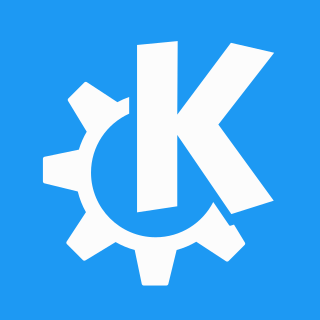
KDE is an international free software community that develops free and open-source software. As a central development hub, it provides tools and resources that allow collaborative work on this kind of software. Well-known products include the Plasma Desktop, KDE Frameworks, and a range of cross-platform applications such as Amarok, digiKam, and Krita that are designed to run on Unix and Unix-like operating systems, Microsoft Windows, and Android.

Calligra Suite is a graphic art and office suite by KDE. It is available for desktop PCs, tablet computers, and smartphones. It contains applications for word processing, spreadsheets, presentation, databases, vector graphics, and digital painting.

Calligra Words is a word processor, which is part of Calligra Suite and developed by KDE as free software.

Calligra Sheets is a free software spreadsheet application that is part of Calligra Suite, an integrated graphic art and office suite developed by KDE.

Calligra Stage is a free presentation program that is part of the Calligra Suite, an integrated office suite developed by KDE.

Kexi is a visual database applications creator tool by KDE, designed to fill the gap between spreadsheets and database solutions requiring more sophisticated development. Kexi can be used for designing and implementing databases, data inserting and processing, and performing queries. It is developed within the Calligra project but is released separately.
The Linux Desktop Testing Project (LDTP) is a testing tool that uses computer assistive technology to automate graphical user interface (GUI) testing. The GUI functionality of an application can be tested in Linux, macOS, Windows, Solaris, FreeBSD, and embedded system environments. The macOS version is named PyATOM, and the Windows version is Cobra. The LDTP is released as free and open-source software under the GNU Lesser General Public License (LGPL).

Krita is a free and open-source raster graphics editor designed primarily for digital art and 2D animation. Originally created for Linux, the software also runs on Windows, macOS, Haiku, Android, and ChromeOS, and features an OpenGL-accelerated canvas, colour management support, an advanced brush engine, non-destructive layers and masks, group-based layer management, vector artwork support, and switchable customisation profiles.

Kugar is a discontinued tool for generating business quality reports for KOffice. The reports can be viewed and printed. It includes a standalone report viewer and a KParts report viewer. The latter means that any K Desktop Environment 3 application can embed the report viewing functionality and that reports can be viewed using the Konqueror browser.

KDE Plasma 4 is the fourth generation of the KDE workspace environments. It consists of three workspaces, each targeting a certain platform: Plasma Desktop for traditional desktop PCs and notebooks, Plasma Netbook for netbooks, and Plasma Active for tablet PCs and similar devices.
A desktop environment is a collection of software designed to give functionality and a certain look and feel to an operating system.
Kross is a scripting framework for KDE Frameworks. Originally Kross was designed for use in KOffice but eventually became the official scripting framework in KDE Software Compilation 4. Kross is designed to provide full scripting power for users of KDE applications, with a language of their own choice; and make it easy for developers targeting the KDE platform to enable their application with support for multiple scripting languages.
Flake or a Vector Shape is a programming library that is used in Calligra Suite and the KOffice 2 series. Flake provides the basic concept of a "shape". To the end user a shape appears as some piece of content such as an image or a text. A shape can be in any form and contain any kind of media since the Shape is responsible for drawing itself. All components of KOffice are being overhauled to use Flake as much as possible.

K Desktop Environment 3 is the third series of releases of the K Desktop Environment. There are six major releases in this series. After the release of KDE 4, version 3.5 was forked into the Trinity Desktop Environment.

K Desktop Environment 2 was the second series of releases of the K Desktop Environment. There were three major releases in this series.

NimbleX is a small Slackware-based Linux distribution optimized to run from a CD, USB drive or a network environment. NimbleX has been praised for how fast it boots, as well as for its small disk footprint, which is considered surprising for a distribution using KDE as desktop environment. NimbleX was also remarked for its website that allows users to generate custom bootable images by using a web browser. It was also covered in mainstream Romanian press as the first Linux distribution put together by a Romanian.

Calligra Plan is a project management application that can create Gantt-style charts and is part of Calligra Suite – formerly included with KOffice.

KOffice was a free and open source office and graphics suite developed by KDE for Unix-like and Windows systems. KOffice contains a word processor (KWord), a spreadsheet (KSpread), a presentation program (KPresenter), and a number of other components that varied over the course of its development.

The KDE Gear is a set of applications and supporting libraries that are developed by the KDE community, primarily used on Linux-based operating systems but mostly multiplatform, and released on a common release schedule.













